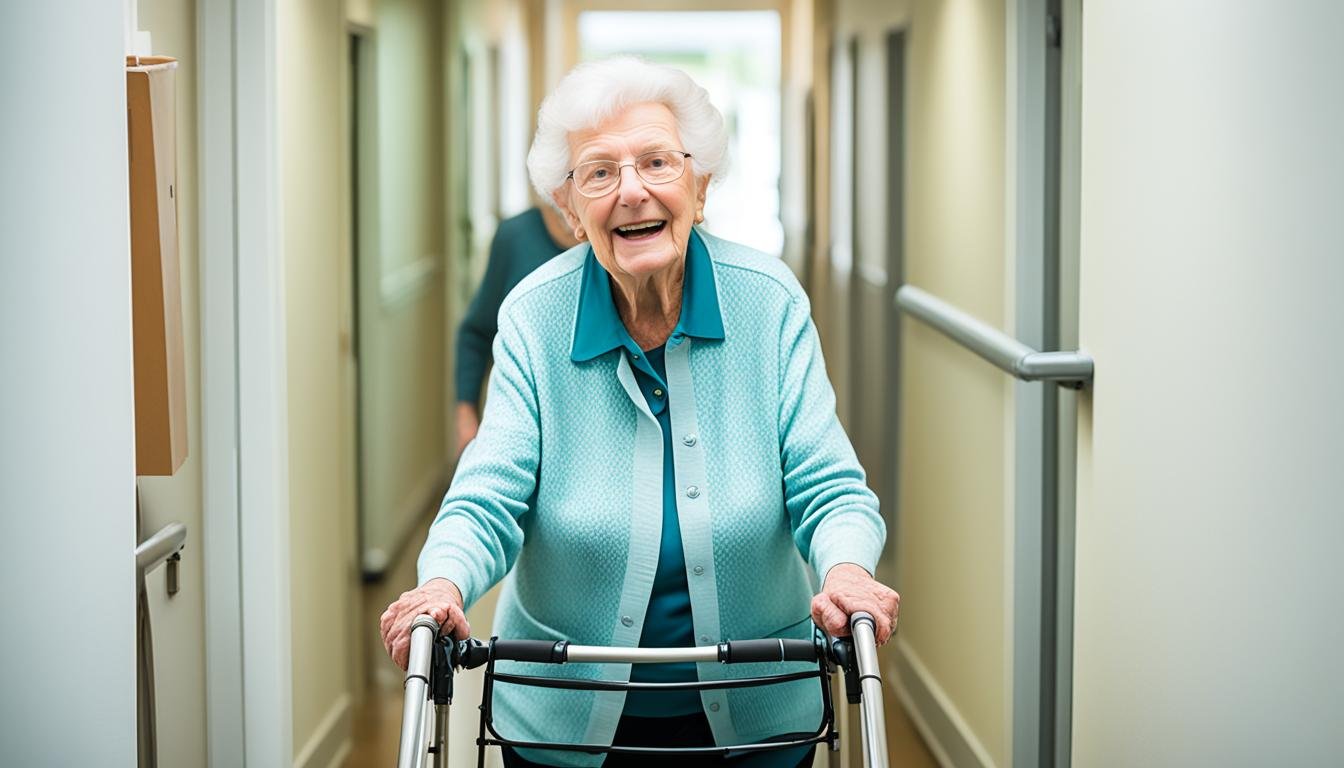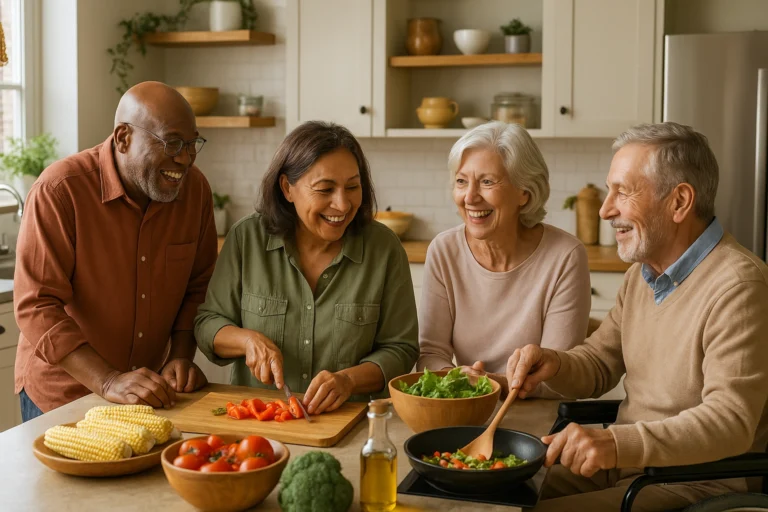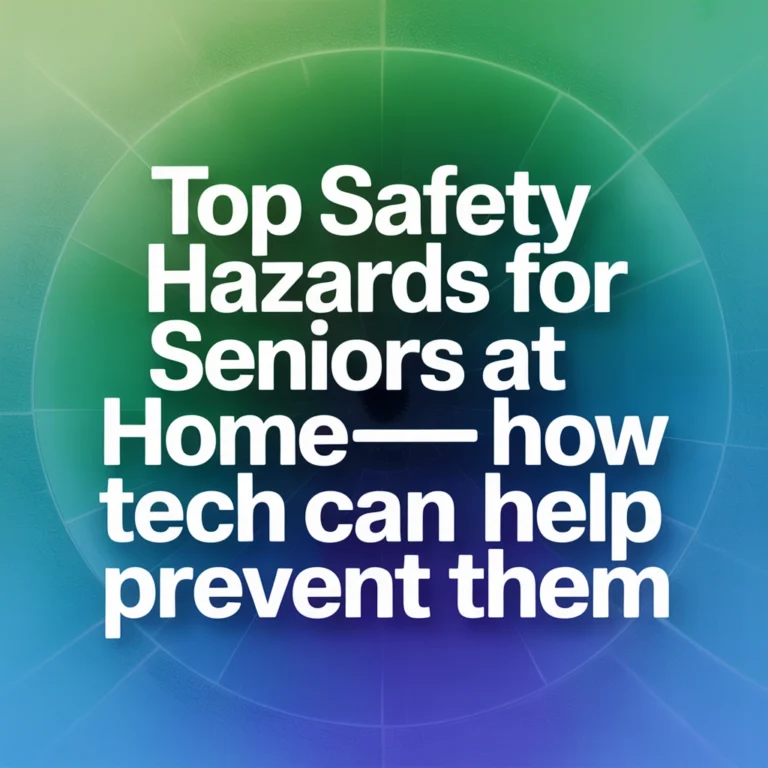Keeping seniors safe and independent at home is crucial. This guide offers 10 key tips to make your home safe and welcoming for older adults. It covers reducing fall risks and using easy technology. These steps help seniors live safely and with confidence.
By making smart changes to your home and using expert advice, you can make a safe space for aging in place. This means seniors can stay in their own homes longer.
Key Takeaways
- Identify and eliminate potential trip hazards in your home to prevent falls
- Install grab bars and easy-to-use seating options to enhance mobility and stability
- Leverage medical alert devices, automatic pill dispensers, and senior-friendly technology to boost home safety
- Evaluate your home room by room to ensure it meets the needs of older adults
- Prioritize modifications that address the unique safety concerns of seniors with dementia
Reduce Fall Risks for Seniors at Home
Falls are a big risk for seniors 65 and older. To keep your aging loved ones safe at home, focus on removing trip hazards and making home changes.
Remove Trip Hazards
First, look around your home for things like area rugs, electrical cords, and low furniture. Use non-slip backing on loose rugs, keep cords tidy, and move furniture to clear paths. Also, check for raised thresholds and make sure outdoor areas are clear.
Install Grab Bars
Grab bars in the bathroom can help seniors stay stable and safe. They can be placed near the toilet, in the shower, and next to the tub. This makes bathing and toileting safer.
Provide Easy Seating
Make sure there’s comfortable seating throughout the home. This helps seniors sit without standing too long and gets them tired. Add kitchen stools, shower chairs, and other seating to make daily tasks easier and prevent falls.
These easy changes can make a big difference in safety and independence for seniors. By tackling fall risks early, you help your senior loved ones stay safe and happy at home.
Easy-to-Use Technology for Senior Home Safety
Seniors want to stay in their homes as they age. Home safety technology helps with this goal. Tools like medical alert devices and smart home gadgets make it easier for older adults to live on their own. Let’s look at some key technologies that can improve your life.
Medical Alert Devices
Medical alert systems with emergency buttons give seniors fast help in emergencies. With a simple button press, they can call for help during falls, medical issues, or urgent situations. Many systems also detect falls automatically, giving extra safety for those living alone.
Automatic Pill Dispensers
Managing pills can be hard, but automatic pill dispensers help. These devices sort, give out, and remind seniors when it’s time for their meds. This helps avoid missing doses or mixing up medications.
Senior-Friendly Phones and Smart Home Devices
For seniors who don’t like a lot of technology, simple phones and devices are great. These phones have big buttons and easy-to-read displays. Smart home devices like voice assistants can remind you, make calls, and control your home easily. These tools keep older adults connected and in control of their homes.
Using these senior-friendly technologies can make you more independent and worry-free. It lets you age in place with confidence.
Home Safety Checklist Room by Room
As seniors age, making their living space safe is key. Start by checking each room for hazards and making changes as needed. This checklist will help you focus on important areas to keep your loved one safe and comfortable.
Entryway and Hallways
- Check for adequate lighting, including motion-activated fixtures
- Ensure all walkways are free of clutter and trip hazards
- Install handrails on both sides of staircases
- Consider adding non-slip mats or runners for traction
Bathrooms
- Install grab bars near the toilet, shower, and bathtub
- Ensure the floor is non-slip, with mats or textured tiles
- Adjust the water temperature to prevent scalding
- Provide a raised toilet seat and shower chair, if needed
Bedroom
- Ensure the bed is at a comfortable height for easy access
- Place frequently used items within easy reach
- Provide adequate lighting, including nightlights
- Check that windows and doors are secure and easy to operate
Kitchen
- Install non-slip flooring and ensure walkways are clear
- Ensure appliances are easy to use and have automatic shut-off features
- Store frequently used items within easy reach
- Consider adding contrasting colors to identify edges and obstacles
By tackling hazards in each room, you can make a safer, more comfortable space for your senior loved one. Remember, a detailed home safety checklist is vital for keeping up with senior home safety audits and supporting aging in place assessments.
How to Make Your Home Safe for Seniors with Dementia
It’s important to make sure seniors with dementia or Alzheimer’s feel safe and comfortable at home. By making some simple changes, you can help them stay independent and happy. Here are some key tips to follow:
Use Appliances with Auto Shut-Off
Seniors with dementia might forget to turn off things like the stove or iron. This can be dangerous. Look for appliances that shut off automatically to prevent fires and keep everyone safe.
Secure Hazardous Areas
It can be hard for seniors with dementia to remember what’s dangerous at home. Secure hazardous spaces like drawers and the garage with locks or latches. This keeps them safe from harm.
Improve Lighting and Clear Pathways
Good lighting and clear paths are key for seniors with Alzheimer’s home safety. Add more lamps and motion-sensor lights. Also, clear the floors and hallways of clutter to prevent trips.
These changes can make it safer for your loved one to stay at home. They help with aging in place with cognitive impairment, supporting their independence and happiness.
Benefits of Professional Home Safety Inspections
Keeping your home safe and easy to move around in is key to staying independent and happy as you get older. Many older adults know how important home safety is, but they might not see the dangers that are right under their noses. That’s where a certified home safety inspection expert can really help.
These pros do deep checks, looking at everything from fire risks and chances of falling to how easy it is to get around. Working with a senior home modification expert, you can spot and fix problems early. This helps you stay in your home as you age. Here are some big pluses of a professional home safety inspection:
- They spot safety risks you might have missed, like loose rugs or dark stairs.
- You get advice on changes and tech to make your home easier to get around in.
- You’ll feel sure your home is safe after an expert checks it out.
- By fixing hazards early, you can avoid accidents that could be costly and dangerous.
- You can stay in your home safely as you get older.
Don’t wait for a fall or accident to check your home’s safety. Get a full home safety inspection now. This lets you age in place with confidence.
“A professional home safety assessment can be the first step towards making your home a safer, more comfortable place to live and age in.”
| Benefit | Description |
|---|---|
| Identify Risks | A certified expert can find safety dangers you might have missed. |
| Customized Recommendations | You get advice on changes and tech to make your home easier to get around in. |
| Peace of Mind | Knowing a pro has checked your home gives you security and confidence. |
| Prevent Accidents | Fixing safety risks early stops costly and dangerous falls or incidents. |
| Support Aging in Place | Home changes let you stay in your own home safely and comfortably as you age. |
Prioritizing Home Modifications for Senior Safety
As you or a loved one ages, making your home safe for seniors might feel like a big task. But, you don’t need to do everything at once. Start with small, affordable changes before looking into bigger ones.
Start Small with Simple Additions
Small changes can greatly improve senior home safety. Some easy, budget-friendly steps include:
- Adding grab bars in the bathroom
- Replacing doorknobs with lever handles
- Improving lighting throughout the home
- Decluttering and removing tripping hazards
- Installing a medical alert system
These simple steps can make your home more accessible and lower the risk of falls. Falls are a top cause of injury for older people.
Seek Expert Advice
For help with making your home safer, talk to a certified aging-in-place specialist or an occupational therapist. They can look at your needs and suggest the best changes. Their advice ensures your home stays safe and supportive as you age.
By starting with small steps and getting expert advice, you can make your home safer and more accessible. With the right changes, you can keep living independently in your own home.
Adapting Any Home for Elderly Accessibility
Many older adults want to stay in their homes as they age. The good news is, with the right changes, any home can become senior-friendly. Whether your home has stairs or is on one level, there are ways to make it easier to move around and live independently.
For homes with stairs, things like chair lifts, ramps, and wider doors help a lot. Single-story homes might just need small changes, like lower counters, grab bars in the bathroom, or smart home tech. Experts can check out your home and suggest the best ways to make it safer and easier to get around.
No matter your home’s size or layout, there are ways to make it better for seniors. Adding senior-friendly home features can turn your home into a place that supports your independence. This lets you stay in your home safely and comfortably as you age.
“With the right adaptations, any home can become more accommodating and accessible for older adults.”
Accessible Home Modifications to Consider
- Chair lifts for multi-story homes
- Ramps for easy entry and exit
- Wider doorways and hallways
- Lowered countertops and cabinets
- Grab bars in bathrooms
- Motion-activated lighting
- Smart home technology for added safety and convenience
| Home Modification | Benefits |
|---|---|
| Chair Lifts | Allows easy movement between floors, reducing fall risk |
| Ramps | Provides accessible entry and exit points, accommodates mobility devices |
| Grab Bars | Enhances stability and balance in the bathroom, preventing falls |
| Smart Home Devices | Offers convenience, safety, and remote monitoring for aging in place |
Adding aging in place home modifications and accessible home design features makes your home better for aging. It helps you stay independent and comfortable in your own home.
Safe In-Home Care Options for Aging in Place
As you or a loved one gets older, staying independent and comfortable at home is key. Luckily, there are many in-home senior care services to help. These services offer everything from companion care and meal delivery to skilled nursing, letting seniors get the care they need at home.
Home health services are a big part of aging in place support. These caregivers help with bathing, dressing, and managing medicines. They also offer occupational and physical therapy to keep seniors moving and safe from falls.
There are also home health technologies that make seniors safer and more independent. For example, medical alert devices can call for help fast, and automatic pill boxes make sure meds are taken on time. By using both in-home care and smart home tech, seniors can stay in their beloved homes with confidence.
“With the right support, aging in place can be a fulfilling and empowering experience for seniors.”
Talking to a senior living advisor can help you find the best in-home care options. They make sure you or your loved one gets the support needed to age safely and comfortably at home. By combining home changes, assistive tech, and professional care, seniors can keep their independence and enjoy their golden years at home.
Introducing the SeniorThrive App
The SeniorThrive app is a top choice for senior home safety and aging in place technology. It helps older adults, caregivers, and families make homes safer and more independent.
This app offers a customizable home safety checklist. It looks at your specific needs and suggests ways to make your home safer. It helps you spot hazards and lower the chance of falls.
The app does more than just check for safety. It works with many smart home devices. This lets you easily check and control your home with a button. You can use it with things like automatic pill boxes, senior phones, and voice helpers.
The app also has tools for caregivers and a community for support. You can meet others, share stories, and find elder care support. It makes you feel supported and connected.
If you’re a senior wanting to stay independent or a caregiver looking after a loved one, this app is essential. It helps you age in place with confidence and ease.

“The SeniorThrive app has been a game-changer for my family. It’s like having a personal assistant for home safety and caregiving, all in the palm of my hand.”
– John Doe, Caregiver
How to Make Your Home Safe for Seniors
Keeping older adults comfortable and independent at home is key. By making smart changes and using new tech, you can make a safer, easier place for them to live. This includes lowering the risk of falls and making safe areas for seniors with dementia. These tips and resources can turn your home into a secure, cozy space.
Prioritize Fall Prevention
Stopping falls is very important for seniors. First, remove things that could trip you up like loose rugs and clutter. Put in grab bars in the bathroom and near stairs, and use non-slip mats in the tub or shower. Make sure there’s enough light in every room, especially where people walk a lot.
Leverage Technology for Assistance
New tech can really help seniors stay safe at home. Things like medical alert devices, pill boxes, and phones made for seniors offer big help. They let seniors call for help quickly, keep track of their meds, and control their home easily.
Secure Hazardous Areas
For seniors with dementia, keeping dangerous spots safe is key. Use appliances that turn off by themselves, lock up cleaners and pills, and make sure paths and lights are clear. This helps prevent falls and wandering.
With these changes, you can make a home that’s safe, comfy, and supports independence for your loved one. Don’t forget, getting advice from a professional safety check can also be very helpful.
“Aging in place is not just about making a home more accessible, it’s about creating a space that nurtures independence, comfort, and security.” – Jane Doe, Certified Aging-in-Place Specialist
Conclusion
Keeping our aging loved ones safe and comfortable at home is very important. By making changes to the home and using easy-to-use technology, seniors can live on their own longer. These 10 tips offer a clear guide to making a safe and easy-to-access living space for older adults.
With the right steps, seniors can keep thriving in their familiar homes. By lowering the risk of falls and adding assistive devices, homes can become safe for the elderly. These steps help make your home a safe place for your aging family members. Putting senior home safety first lets your loved ones age in place with confidence and peace.
The secret to supporting senior independence and well-being is a complete, active approach to home safety and accessibility. By investing in these key home changes and safety steps, you can make a space that lets your loved ones live their best lives. They can stay in the homes they love, surrounded by comfort and memories.
Source Links
- https://www.ncoa.org/adviser/sleep/home-safety-older-adults/ – Home Safety for Older Adults: A Comprehensive Guide 2024
- https://www.healthinaging.org/tools-and-tips/tip-sheet-home-safety-tips-older-adults – Home Safety Tips for Older Adults
- https://www.aplaceformom.com/caregiver-resources/articles/home-safety-tips – Home Safety for the Elderly: Tips & Checklist



